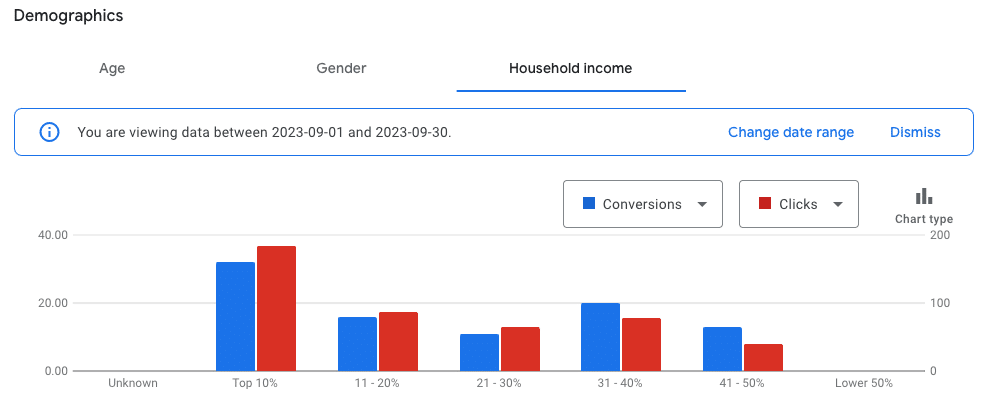How Much Should Divorce Law Firms Spend on PPC Marketing?
- Brent Harkins
A well-known legal marketing professional recently sent an email about PPC marketing saying, “If you’re a high-end divorce attorney, it’s almost $50 per click.” This shocked me as we manage six-figures of monthly Google Ads spend across the largest markets in the country and in our accounts, cost-per-click (CPC) are half of that. Now before anyone objects that we spend less per click because we’re not targeting high-end prospects, that’s not the case. We implement a sophisticated bid strategy emphasizing the top 20% of household incomes and retainer-ready search terms.
In this blog I’m going to share our secret strategies on how we target, bid, and scale Google Ads PPC marketing for divorce and family law firms.
Determining How Many Clients Your Law Firm Needs
To determine budget, we work backwards from the end result, client acquisition. For example, a fully scaled attorney at 40 cases needs on average four new clients a month to maintain that caseload. These are $5,000 – $10,000 retainer cases that require strong representation but are not as complex or time-consuming as high-net-worth cases involving millions of dollars worth of assets, businesses, and multiple properties or highly contested and combative cases.
With that you can simply insert the number of attorneys on staff, multiply by 4, and have the total number of new clients your practice needs per month. Now this is a baseline number. If you need to scale a new associate’s caseload up you may need more, if you have attorneys in cases going to trial, you may need less but this is the average number to guide your needs.
The Conversion Rate Optimization Formula
With a well-built Google Ads account and campaigns, you can expect to convert 10% of your leads into clients at a minimum. This should be your guide,for every 40 leads, you’ll sign 4 clients to meet your baseline goal per attorney. To generate 40 leads, you continue to work backwards creating a formula using the conversion rate and click-through-rate (CTR) to come up with the number of times your ads need to be served, known as impressions.
This is where strategic campaign management and conversion rate optimization can supercharge your marketing. By finding your top performing ad groups and ads, you can drive more impressions on your champion variants resulting in a higher CTR and lower CPC.
The next step is to optimize the page or form you are directing traffic to. According to Unbounce, the average lead generation conversion rate for legal industry landing pages is 3.3%. Improving that to 5%, 10%, or 15% can have a massive impact improving your initial return on investment allowing you to scale your law firm’s PPC marketing.
Divorce and Family Law PPC Keyword Strategy
Not all keywords are created equal so your bids and budget should reflect this. If given the choice between “city modifier + divorce attorney” (ex: “Denver divorce attorney”) and “city modifier + child support attorney” search terms, most attorneys will select the divorce search term. Searches for services like alimony, spousal support, and child support, while tenable and potentially profitable, do not generally have the same client acquisition rate as terms around divorce and custody because there is usually greater pricing conflict when it comes to retainers for those services.
Take this a step further and you may be able to implement a higher-funnel strategy where prospects are in the research phase with a search term like, “how to get a divorce in [insert state modifier],” for a lower cost-per-click. The warning I will need to provide is that these prospects will require sufficient nurturing or retargeting as it is less likely that they are in the decision making phase of evaluating different attorneys, but simply gathering the information needed to prepare themselves.
Understanding Outside Factors Impacting Marketing Costs
If you are a brand new law firm, you will likely need to budget more. Your Google Ads account will not have the history of ad spend and performance that benefits older accounts. If your divorce and family law practice has a limited online presence without placement in local search or organic results, you will be more reliant on the paid search placements requiring a more aggressive bid strategy.
There are also geographic implications due to the level of competition. For example, our client with offices in Manhattan and Brooklyn, New York, which many would consider the most competitive market in the country, actually spends slightly less than our client in San Diego. Major markets require the same budget more-or-less while smaller markets like our own practices in Albuquerque, New Mexico and Omaha, Nebraska can spend much less due to fewer competitors bidding on the same keywords.
In addition, you will occasionally have bigger law firms or new advertisers that push up the marketing investment for all firms. While many new advertisers are flashes in the pan that don’t have the capital to maintain this strategy, there are new competitors such as Marble working on a national level with considerable financial backing.
Three Metrics to Monitor to Guide Your Law Firm Advertising Budget
Google provides data to evaluate your campaigns’ performance but what about the competition? Within your campaigns lives the auction insights. This is where you can evaluate key-performance-indicators (KPIs) against your direct competitors.
In addition to these data-points, Google also offers metrics on your market share through three data-points: search impression share, lost due to rank, and lost due to budget. These are provided as percentages with the three adding up to 100%.
What do these data points mean? Below are their definitions provided by Google.
- Impression share (IS) is the percentage of impressions that your ads receive compared to the total number of impressions that your ads could get. Impression share = impressions / total eligible impressions.
- Search lost IS (rank): This is the percentage of time your ad didn’t appear because of poor ad rank, which is determined by your bid relative to your competitors and by your ad quality. Learn more about ad rank and how to improve it.
- Search lost IS (budget): This is the percentage of time your ad didn’t appear because your budget is too low. Depending on the budget delivery method you’ve set for a campaign, your ads may appear in the morning, but then your daily budget runs out and prevents you from bidding in the afternoon.
Monitoring these data points are imperative for your ability to manage your ad accounts bids and budgets effectively.
Austin Law Firm PPC Case Study
We began working with a startup boutique family law practice in Austin, Texas this past spring. While the three founding partners had casework they were bringing from their former employer, they needed to supplement and scale casework with advertising. In addition, they had a business plan to add associates to staff who would need to be more reliant on marketing generated clients as opposed to referrals.
With an initial advertising budget of $7,500 they were immediately competitive. After their account exited Google’s learning phase and optimizations were made by the Cardinal Concepts search engine marketing team, we were able to help them expand their law firm marketing and grow their practice to now include five associates on staff. As mentioned earlier in this blog, this is through highly targeted and strategic campaign structure and bidding. You will see that the top 10% of household income demographic targeting was by far their most prevalent while maintaining cost-effective CPCs.


Working with a Legal Marketing Agency
At Cardinal Concepts, we have decades of legal marketing experience that have grown our CEO’s own divorce and family law practice to $20 million in revenue a year. This subject matter expertise in law firm PPC marketing and deep understanding of the interconnectivity to your intake and operations allows us to partner with clients in ways that no other agencies can. If you’re ready to make a positive investment into your practice, schedule a free strategy session with our team. We’ll provide a competitive analysis to help you understand where you are and what levels of success you can reach.
If you’re simply looking to learn more about paid search marketing for your law firm, we have a must-read eBook that is free to download, The Undefeated Playbook to Google Ads for Attorneys.
Pay-per-click advertising can be daunting but hopefully this blog provides clarity into how to plan and succeed in this competitive but lucrative marketing channel for divorce and family law firms.


